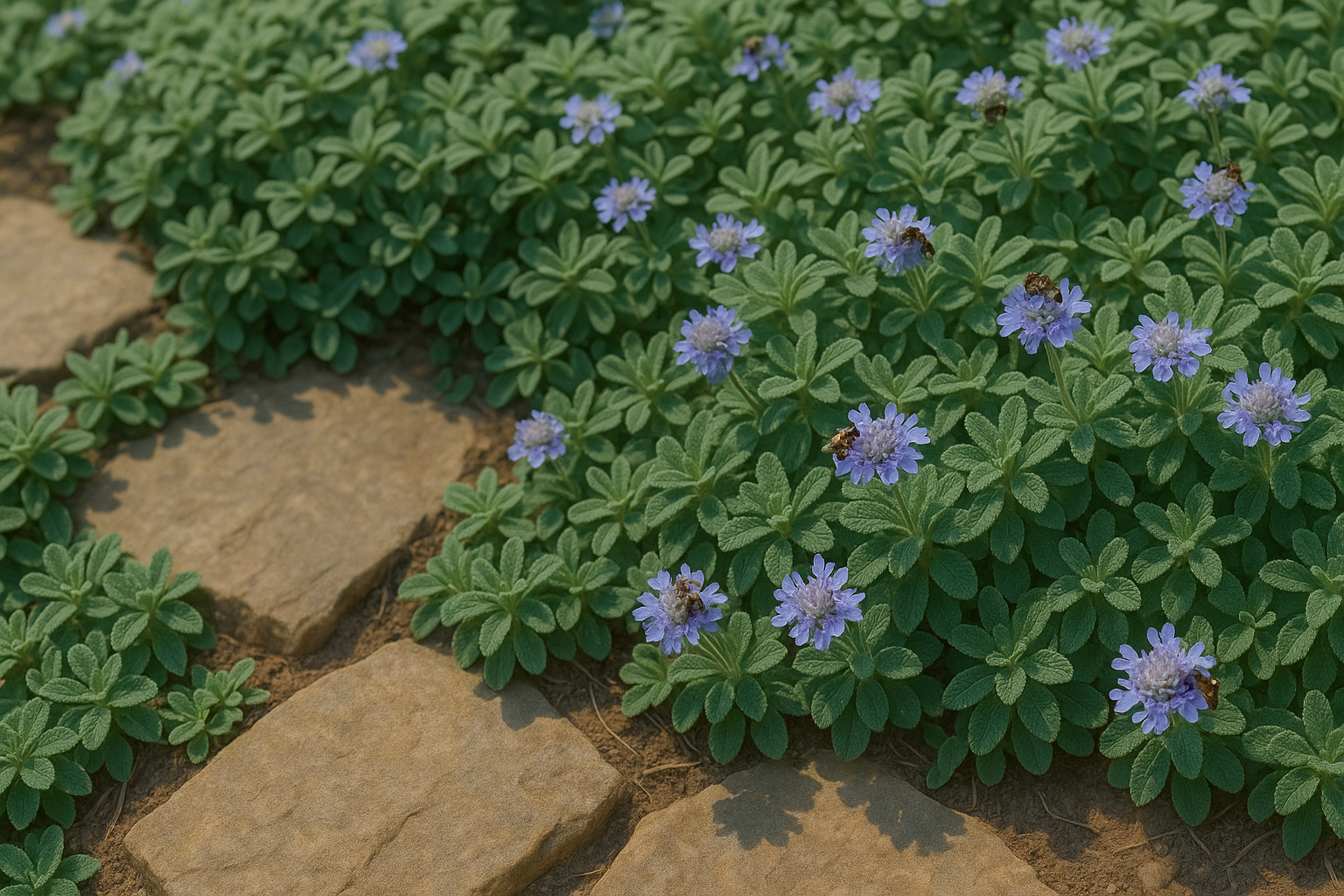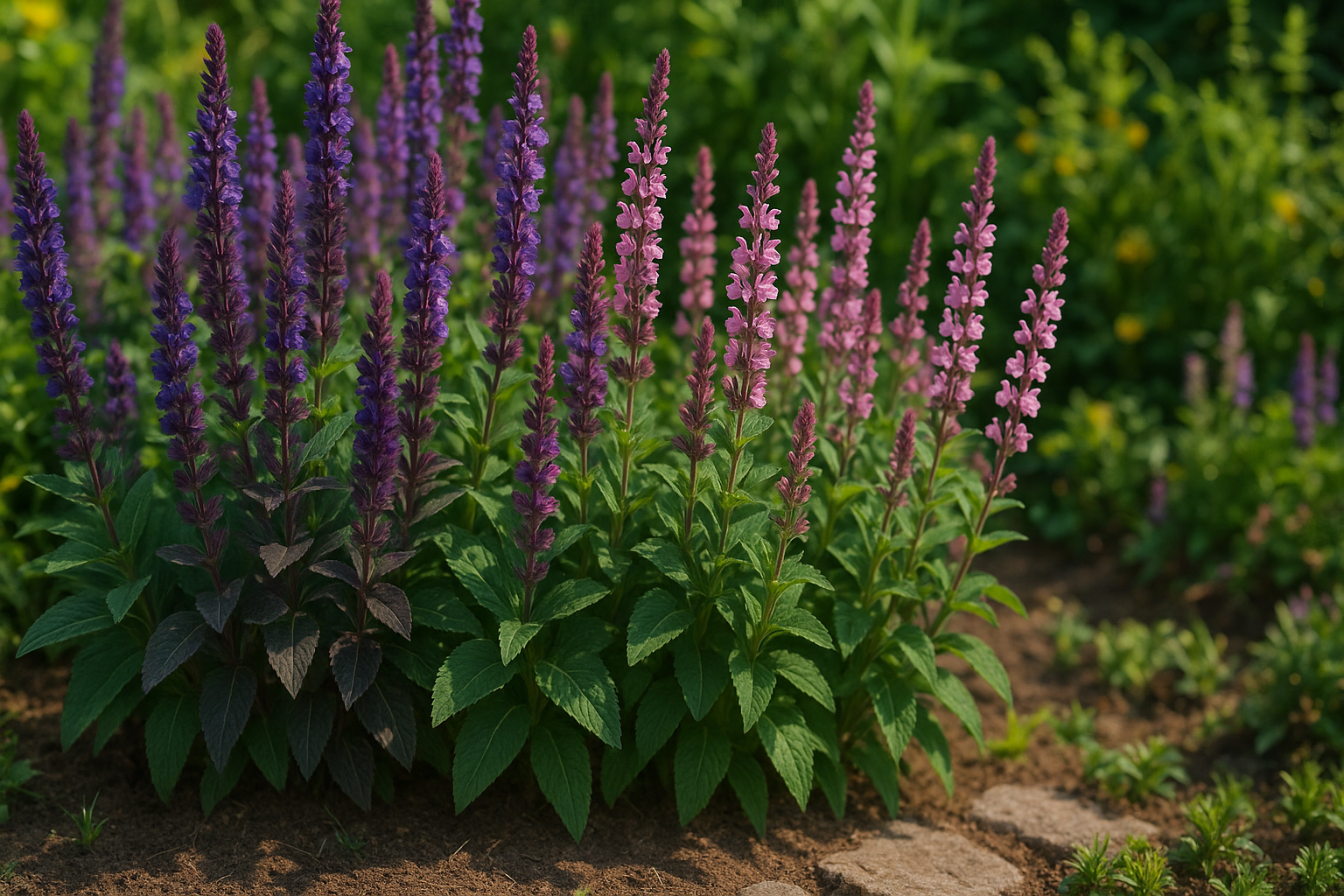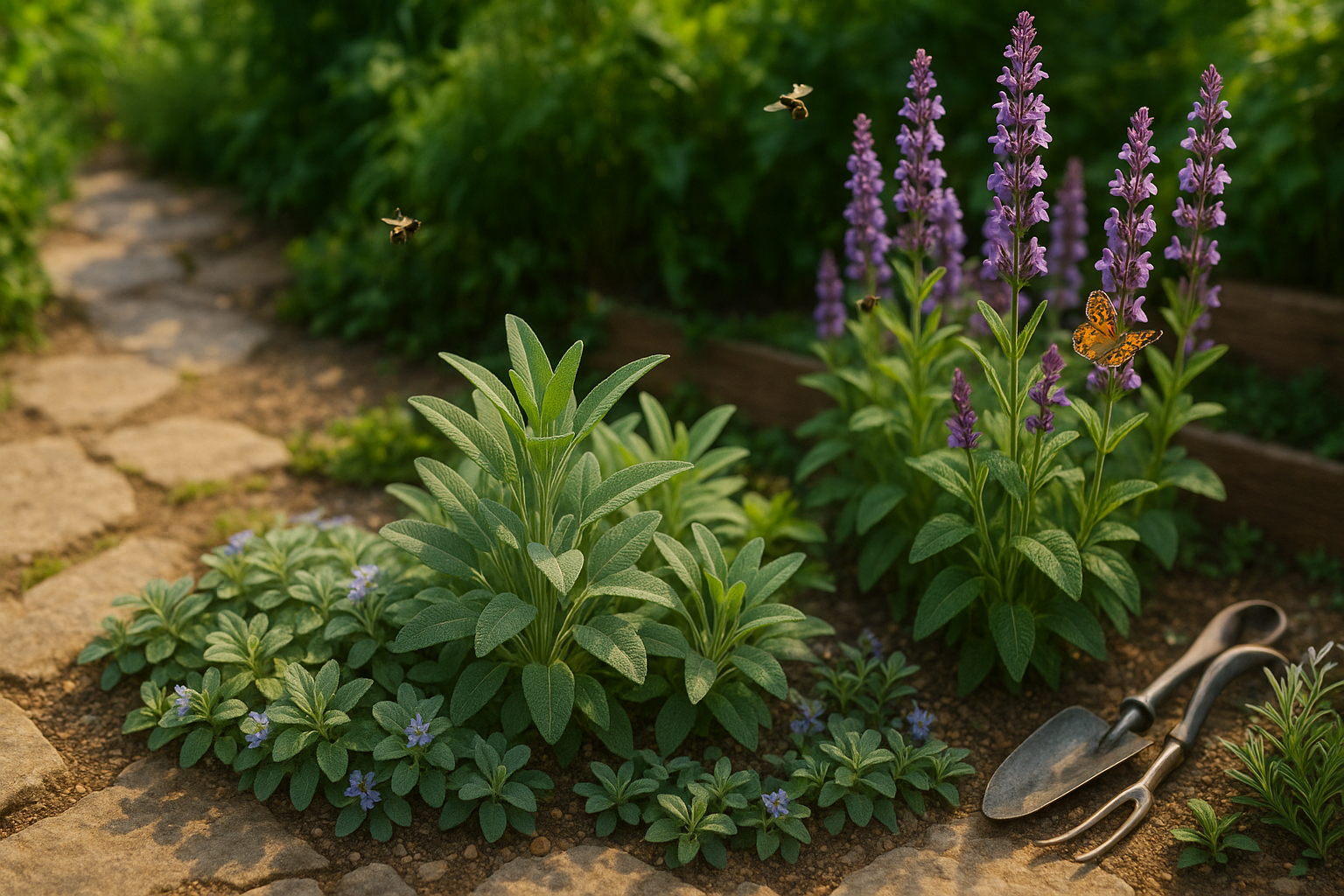Introduction
Sage (Salvia) has long been cherished by gardeners for its aromatic leaves, vibrant blooms, and ability to thrive in a range of climates. When it comes to choosing the right variety, the debate between creeping vs. upright sage often arises. With so many types available, knowing the difference can help you maximize both the beauty and functionality of your garden.
Creeping sage varieties, with their low-growing, spreading habit, make excellent ground covers. They work wonders for filling in gaps between stepping stones or cascading gently over borders. In contrast, upright sage varieties stand tall, offering vertical interest, fragrant foliage, and often showy flowers that attract pollinators.
If you’re reimagining a herb bed, designing a pollinator patch, or looking to control erosion, choosing the right sage form can make all the difference. Throughout this post, we’ll explore the unique qualities of creeping and upright sage, how each can solve common gardening challenges, and share tips on caring for both.
Whether you have a sprawling backyard or a small container garden, understanding the strengths of each form will help you make the most of sage’s versatility in your landscape.
Understanding Sage (Salvia)
The Salvia genus, commonly known as sage, is a diverse group of plants with over 900 species, earning a well-deserved spot in gardens worldwide. Gardeners love sage for its easy-care nature and the vibrant range of colors it offers—from the purple-blue spikes of Salvia nemorosa to the fiery reds of Salvia splendens.
One reason Salvia is so popular is its universally attractive, aromatic foliage. Most varieties have textured, slightly fuzzy leaves that release a pleasant, herbal scent when touched or brushed against, creating a sensory experience in the garden. Their blooms, usually clustered along upright stems, are not only visually striking but also long-lasting, with many blooming from early summer well into fall.
Beyond their beauty, sages play an important ecological role. Their nectar-rich flowers are specially shaped to attract valuable pollinators such as bees, butterflies, and hummingbirds. For example, the tubular blossoms of varieties like Salvia guaranitica are especially appealing to hummingbirds, while others draw in swarms of honeybees.
In addition to supporting local wildlife, Salvias are commonly used as ornamental border plants, mass plantings for color drifts, or even in container gardens for smaller spaces. They’re drought-tolerant and thrive in sunny spots with well-drained soil, making them both practical and decorative.
Whether you want to boost biodiversity in your backyard or simply add sustained seasonal color, sage is a genus that delivers—offering beauty, fragrance, and vital resources for garden pollinators.
Creeping Sage Varieties

Creeping sage is a versatile group of low-growing, mat-forming perennial herbs in the Salvia genus, prized for their beauty and practicality in gardens. One of the most well-known species is Salvia sonomensis, also called Sonoma sage, native to the dry hills of California.
These plants typically grow just 6 to 12 inches tall but spread widely to form dense carpets of aromatic leaves, often silver-green or grayish. In late spring and early summer, creeping sages burst into masses of small, pale blue to violet flowers that attract bees, butterflies, and hummingbirds, making them ideal for pollinator-friendly spaces.
Their tough, drought-resistant nature makes them perfect for low-water gardens, and their spreading habit means they fill in empty spaces quickly—making them excellent groundcovers and natural solutions for erosion control on banks or slopes. Along borders or between stepping stones, creeping sages can soften hard edges and suppress weeds while adding seasonal color and fragrance.
Popular Cultivars
- ‘Bee’s Bliss’ — beloved for especially showy blooms and rapid growth
- ‘Mrs. Beard’ — stands out for its superior disease resistance and dense foliage
For gardeners in hot, dry climates, these tough sages provide lasting, low-maintenance beauty, adapting well to rocky ground or poor soil where many other plants struggle. For best results, give them full sun and good drainage—once established, they need little water or care.
Mixing various creeping sage species and cultivars throughout your landscape can create a dynamic, wildlife-friendly carpet that thrives year after year.
Upright Sage Varieties

Upright sage varieties, especially species like Salvia nemorosa (Wood Sage) and Salvia officinalis (Common Sage), bring both structure and color to gardens with their distinctive vertical growth habits. Unlike sprawling or low-growing sages, upright types form tall, sturdy stems often reaching 18 to 36 inches, topped with dramatic spikes of blue, purple, or pink flowers.
Salvia nemorosa is prized for its dense, upright mounds of lance-shaped foliage and long-lasting flower spikes that attract pollinators all summer. In contrast, Salvia officinalis offers not only striking lilac flowers but also edible, aromatic gray-green leaves—an essential for any herb lover. Both are drought-tolerant and thrive in full sun, making them especially valuable for low-maintenance or xeriscape gardens.
Their upright habit provides strong vertical accents in mixed borders, breaking up mounded plantings and adding visual rhythm. For example, planting tall varieties like Salvia nemorosa ‘Caradonna’—with its deep purple flower stalks—among softer perennials gives the bed a professionally designed feel with layers and depth.
In herb gardens, upright sages such as Salvia officinalis ‘Berggarten’ combine beauty and utility, offering robust flavor for culinary use while also creating neat, compact hedges or grid patterns. For gardeners seeking extra flair, standout varieties like Salvia nemorosa ‘Amethyst’ dazzle with pink-toned flowers, while Salvia officinalis ‘Purpurascens’ features attractive purple leaves.
Upright sages are easy to establish, deer-resistant, and require little pruning beyond a late-spring tidy-up—making them a versatile choice for adding form, function, and pollinator-friendly color to beds, borders, and garden designs of all sizes.
Creeping vs Upright Sage
When choosing between creeping and upright sage, understanding their distinct qualities helps you maximize both form and function in your garden. Creeping sage (such as Salvia sonomensis) hugs the ground, growing just 6 to 12 inches tall but spreading up to 3 feet, creating a lush, fragrant mat that’s ideal for ground cover, softening the edges of pathways, and holding soil on slopes.
In contrast, upright sage varieties like Salvia officinalis typically reach 18 to 30 inches high, with a bushier growth that commands attention in herb beds or as a decorative accent beside taller flowers.
Visually, creeping sage produces subtle, delicate blue-purple flowers close to the foliage for a carpet of color—usually blooming from late spring to early summer—while upright sage dazzles with showy spikes of purple, blue, pink, or even white blooms throughout summer and often into fall.
Maintenance-wise, creeping sage is low-effort: it’s drought-tolerant, disease-resistant, and rarely needs shaping, making it perfect for low-maintenance gardening or erosion control. Upright sage, however, benefits from periodic pruning to keep its form and encourage fresh growth; it also thrives in containers for small spaces or kitchen gardens where its aromatic leaves are easy to harvest.
Consider situational advantages: use creeping sage for slopes, between stepping stones, or as a living mulch, and turn to upright sage for sensory gardens, kitchen use, or as pollinator magnets in borders.
Quick Reference:
- Growth Habit: Creeping sage—low, sprawling; Upright sage—tall, bushy
- Height/Spread: Creeping (6–12″ tall, 2–3’ spread), Upright (18–30″ tall, 18–24″ spread)
- Blooms: Creeping (late spring–early summer, blue-purple); Upright (summer–fall, purple/blue/pink/white)
- Maintenance: Creeping (low); Upright (moderate—needs occasional pruning)
- Best Uses: Creeping (groundcover, slopes, fillers); Upright (containers, herb beds, pollinator gardens)
Choosing the Right Sage for Your Garden
Selecting the best sage varieties for your garden starts with understanding your site’s conditions. Most sages, including popular types like Salvia officinalis (culinary sage) and Salvia nemorosa (ornamental sage), thrive in full sun, though some, like woodland sage, can tolerate partial shade.
If your area is prone to heat or drought, try drought-tolerant varieties such as Mexican bush sage, which can handle intense sun and dry spells. Sage plants generally dislike soggy roots, so pick a well-draining spot and amend your soil with sand or fine gravel if it’s heavy clay—think Mediterranean: lean, somewhat rocky, but never waterlogged.
For visual interest across seasons, combine upright sages, which produce bold spikes of color, with low-growing creeping sages like Salvia sonomensis. This pairing creates a lush, layered effect and benefits pollinators by offering nectar at different heights and times.
As a beginner, start with nursery-grown transplants or well-rooted cuttings, as they establish faster than seeds. After planting, water your new sages regularly for the first few weeks, but let the top inch of soil dry out between waterings to prevent root rot. Mulch lightly with pea gravel or compost to suppress weeds and retain moisture, but avoid piling mulch right against the stems.
With these basics in mind, you’ll boost both curb appeal and local biodiversity, making your garden a sanctuary for bees and butterflies—while enjoying aromatic leaves and vibrant flowers all year round.
Growing, Caring, and Troubleshooting Sage
Growing sage, whether it’s common garden sage (Salvia officinalis) or the more delicate pineapple sage (Salvia elegans), starts with choosing well-drained soil—think sandy or loamy, not heavy clay. Both types appreciate six to eight hours of direct sunlight, although pineapple sage can tolerate a bit more moisture and partial shade.
When watering, let the top inch of soil dry out between sessions to prevent root rot—a frequent problem when sage is over-loved. Water at the base to keep foliage dry, which helps ward off powdery mildew. Pruning is essential, especially in spring: trim back older stems to encourage bushy, robust growth and avoid leggy, scraggly plants.
Fertilizing should be light. Use compost or a diluted all-purpose fertilizer once in spring, as too much nitrogen can dilute sage’s flavor and make the plant more susceptible to disease. Watch for common pests such as aphids and spider mites; a strong spray of water or an application of insecticidal soap usually helps.
Mildew, often showing as whitish patches on leaves, thrives in humid or crowded conditions—space your plants 18-24 inches apart and prune out dense growth to boost airflow. If your sage looks leggy, give it more light and pinch back new growth regularly for a fuller shape.
Overwatering is a common issue—yellowing leaves are a giveaway. Cut back on water and check that pots have adequate drainage holes. For potted sage, terracotta containers help wick away excess moisture. If you spot black leaves or mushy stems, trim off the affected parts and let the soil dry before watering again.
By giving sage sunlight, well-drained soil, and some occasional care, you’ll have a thriving herb at your fingertips for seasoning and tea.
Conclusion & Quick Planting Ideas
Both creeping and upright sage varieties offer unique benefits, making them versatile stars in any garden. Creeping sage quickly covers bare patches, softening pathways and providing a fragrant groundcover, while upright sages add height and color with their stately blooms, attracting pollinators like bees and butterflies.
Don’t be afraid to experiment—combine creeping sage with low-growing ornamental grasses for a textured, drought-tolerant border, or plant upright sage alongside lavender for a pairing that thrives in full sun with minimal maintenance. Native plants such as coneflowers or goldenrod also create beautiful, resilient combinations when tucked near sage, supporting local wildlife and keeping your garden vibrant through the seasons.
Whether you’re filling in gaps between stepping stones or designing a colorful herb patch, sage adapts well and rewards creative planting ideas. Have you tried mixing different sage types or pairing them with favorite perennials? We’d love to hear how you’ve used sage in your own garden—share your stories, tips, or photos in the comments below and let’s inspire each other to grow something beautiful!
